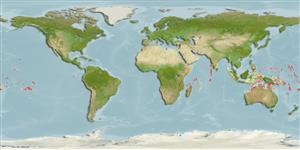Environment: milieu / climate zone / depth range / distribution range
Ökologie
seewasser; süßwasser; brackwasser riff-verbunden; tiefenbereich 0 - 5 m (Ref. 86942). Tropical; 14°N - 18°S
Indo-Pacific: East Africa to the Society Islands (Ref. 1602).
Size / Gewicht / Alter
Maturity: Lm ? range ? - ? cm
Max length : 3.5 cm TL Männchen/unbestimmt; (Ref. 4343)
Rückenflossenstacheln (insgesamt): 5 - 6; Rückenflossenweichstrahlen (insgesamt): 14; Afterflossenstacheln 1; Afterflossenweichstrahlen: 13. Diagnosis: Characterized by translucent whitish colour with brown speckling and reddish smudge on occipital region; broadly separated spinous and soft portions of dorsal rays, fully connected by membrane, a broader gap between fifth and sixth dorsal spines compared to gap between previous spines; fourth to seventh pectoral-fin rays branched; pelvic fins separated to base with branched rays; 10 cirri on lower edge of gill cover instead of scalloped margin; depth of body 8.5-10.2 times in standard length, head length 3.9-4.3 in standard length; narrow interorbital space, less than half of eye diameter (Ref. 90102).
Inhabits sandy areas subject to strong wave action (Ref. 1602). Also reported from freshwater streams, mainly where freshwater streams ran dead in beach (Ref. 404, 4343). It feeds on polychaetes (Ref. 4343). Of no commercial interest but may be taken incidentally (Ref. 48316).
Life cycle and mating behavior
Geschlechtsreife | Fortpflanzung | Ablaichen | Eier | Fecundity | Larven
Myers, R.F., 1991. Micronesian reef fishes. Second Ed. Coral Graphics, Barrigada, Guam. 298 p. (Ref. 1602)
IUCN Rote Liste Status (Ref. 130435)
Bedrohung für Menschen
Harmless
Nutzung durch Menschen
Mehr Information
NamenSynonymeMetabolismusRäuberÖkotoxikologieFortpflanzungGeschlechtsreifeAblaichenSpawning aggregationFecundityEierEientwicklung
ReferenzenAquakulturAquakultur ProfilZuchtlinienGenetikElectrophoresesVererbbarkeitKrankheitenVerarbeitungNutrientsMass conversion
Tools
Zusatzinformationen
Download XML
Internet Quellen
Estimates based on models
Preferred temperature (Ref.
123201): 27 - 29.4, mean 28.5 °C (based on 1178 cells).
Phylogenetic diversity index (Ref.
82804): PD
50 = 0.5098 [Uniqueness, from 0.5 = low to 2.0 = high].
Bayesian length-weight: a=0.00102 (0.00046 - 0.00225), b=3.06 (2.88 - 3.24), in cm total length, based on all LWR estimates for this body shape (Ref.
93245).
Trophic level (Ref.
69278): 3.1 ±0.26 se; based on food items.
Fishing Vulnerability (Ref.
59153): Low vulnerability (10 of 100).
